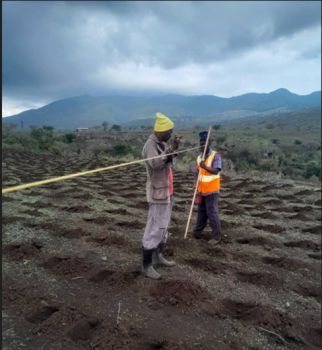Sowing Along the Slope: Contour Planting as a Nature-Based Solution for Healthier Soil
Posted on behalf of: Dr Cynthia Olumba, Cranfield University, UK
Last updated: Tuesday, 25 November 2025

Implementing contour farming on the REAL NbS project experimental field in Tanzania

Arable crops planted across the slope / on the contour to intercept surface flow and eroded soil. Note the perennial grass strips (also planted on the contour line).
The degradation of agricultural land is a serious challenge in many parts of East Africa, where steep slopes, heavy seasonal rains, and deforestation have left vast areas of farmland increasingly vulnerable to soil erosion. The continuous loss of nutrient-rich topsoil not only reduces crop productivity; it also undermines the livelihoods of many smallholder farmers who depend heavily on the land. One effective nature-based solution gaining momentum to address this problem is contour farming (also known as contour planting), a traditional practice that has gained renewed relevance. Typically used on sloping land, contour planting mitigates soil and water losses by aligning agricultural field operations with the natural landscape, delivering both ecological and economic benefits.
What Is Contour Farming?
Contour farming is a way of planting crops that follows the natural shape and slope of the land. Instead of planting straight up and down a hill, farmers plant along the curves or “contours” of the slope. By creating a pattern of ridges and furrows that run across the slope rather than up and down, the flow of water is slowed, allowing more water to infiltrate the soil and less soil nutrients to be washed away. This practice enhances soil fertility, increases crop yield, and is especially useful in hilly or sloped regions.
Contour Farming as a Nature-based Solution
Nature-based solutions (NbS) leverage the power of ecosystems to tackle environmental challenges. Contour farming fits this model perfectly, as this agricultural practice uses the natural topography of the land to control water, conserve soil, and improve crop productivity—without relying on heavy infrastructure or synthetic interventions.
Contour farming is one of the NbS being tested within the REAL NbS project. This farming practice was co-selected during the inception workshop held in Tanzania last year. With support from the project team, some farmers are now implementing contour farming on test plots in their fields and monitoring its effectiveness in reducing land degradation.
How Contour Farming Works
Carrying out farming operations on the contour is straightforward and can be done with simple tools:
- Mark contour lines: Farmers first locate the natural contour lines of the land using tools such as an A-frame level or other basic levelling devices.
- Mark the contours: Once identified, the contour lines are marked on the ground using sticks, pegs or ropes. These marks show farmers exactly where to plant so that the crop rows follow the slope’s shape.
- Plant along the contours: Crops are then planted along these marked lines, creating rows of small furrows and ridges. These ridges act as barriers that slow water flow, trap soil, and allow water to soak into the ground.
Why Farm on the Contour?
When surface water flows down a slope without obstruction, it can wash away nutrient-rich topsoil. However, planting along the contours of the land helps to:
- Reduce Soil Erosion – By following the natural shape of the land, contour farming slows the flow of water, reducing its energy to pick up soil particles. This prevents the loss of topsoil, which is crucial for maintaining soil fertility.
- Improve Water Retention – Contour ridges act as mini-reservoirs, allowing rainwater to seep into the soil rather than running off the surface. Holding on to precious water in the soil is especially important during dry periods.
- Enhance Crop Yields – With less soil erosion and better water retention, crops can access more moisture and nutrients, resulting in healthier plants, higher yields and better productivity.
- Prevent Runoff and Flooding – Slowing water flow helps prevent downstream flooding and reduces the risk of nutrient loss from agricultural fields.
Challenges and Opportunities
Despite its benefits, contour planting can present several challenges:
- Labour demands: Mapping and marking the contours require effort, especially on large farms and those with complex topography.
- Limited mechanisation: On slopes with gradients > 7o (12%), traditional farm machinery may need adaptation to operate along contour lines.
- Knowledge gaps: Many smallholder farmers lack training in contour farming techniques.
- Low spots: the crop rows must follow the contour. If the rows dip below the contour, surface water will concentrate at these low spots, leading to local waterlogging and increased risk of soil erosion.
Conclusion
Contour planting is a practical, low-cost, and sustainable nature-based solution. By following the natural contours of the land, farmers can conserve soil, improve water retention, and ensure long-term productivity. In an era of climate change and increasing land degradation, contour planting offers an effective and nature-friendly way to preserve farmland, protect livelihoods, and build resilient agricultural systems.
Photo credit: Jane Rickson from Cranfield University, UK, and our partner team from Nelson Mandela Institute of African Institute of Science and Technology in Arusha, Tanzania.
This work is supported by UK Research and Innovation Building a Green Future strategic theme, Building a Secure and Resilient World strategic theme, Natural Environment Research Council, and the Foreign Commonwealth and Development Office (grant number NE/Z503447/1).

